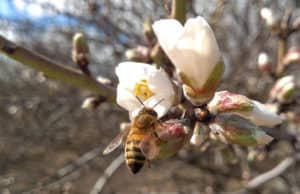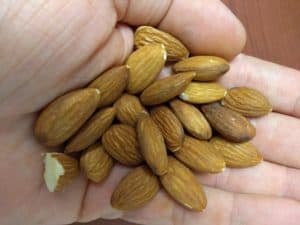There are plenty of quick stats you come across working around bees: At peak population, a strong colony can have over 60,000 individual bees. A queen is capable of laying more eggs in a day (up to 2,000) than there are minutes in a day (1,440). A single bee can produce 1/12 tsp honey in its lifespan and may cumulatively travel 500 miles during the several weeks it spends as a forager. Despite annual losses in the 30-40% range, the total managed colony numbers remains fairly constant at about 3 million.
The American bee industry is inextricably linked to the almond industry. Every year, about 3/4 of the national herd migrates from various wintering locations to the central valley of California for the almond bloom in February. The almond industry also has some eye-opening statistics: The 117,000,000 almond-producing trees in California are responsible for 82% of global almond production, and it is estimated that it takes approximately 1 gallon of water to produce a single almond. The Almond Board of California does a fantastic job summarizing and quantifying the industry in the annual Almond Almanac available here. A couple previous BIP blogs discussing bees and almonds are available here and here.
Given the link between almond and bee industries and the eye-opening numbers in both, it got me wondering how many almonds each bee produces, or how many bees it takes to produce a single kernel (almonds aren’t technically nuts). Do you think a single bee accounts for hundreds of almonds? Does it take dozens of bees to produce each almond? Pick a number and we’ll work through some estimates to see how close you come.

The population of honey bee colonies is often estimated in a unit called frames of bees (FOBs). A frame of bees is defined as a deep frame (apx 19” x 8.5”) well-covered with adult bees on both sides. Estimates range between 2000 and 3000 individual bees per frame. For the sake of this exercise I’ll use the 2400 bees per FOB estimate reported here.
Beekeepers that rent their colonies for almond pollination typically do so under a contract that specifies both a minimum acceptable size and an average colony size that must be met. A commonly used contract may specify a 4 FOB minimum and an overall average of at least 8 FOB with potential bonus payments for colonies exceeding standards. During the month of February 2018, Bee Informed Partnership Tech Transfer Teams inspected over 1,100 colonies from 38 different operations with the overall mean frame count being 8.96 FOB per colony, so we’ll use that number as an estimate for colony strength. It is worth noting that not all bees in a colony are foragers and the percentage of individual bees that forage increases with colony strength. Randy Oliver has an excellent summation of the pollination value of a colony relative to FOB available here. Considering the difficulty of accounting for variable percentage of foragers and also the fact that a colony could not function with foragers alone, we will consider the total number of bees present to all be needed in order to provide pollination.
It is estimated that in recent years approximately 1.9 colonies per bearing acre have been required to meet almond pollination demand. For the 2017/18 almond crop year, there were an estimated 1,000,000 bearing acres. For the same year there was an average yield of 2,270 almonds lbs/acre. For a total crop of 2.27 billion pounds. It is estimated that there are 368 almond kernels per pound.
Having accumulated the numbers above we can now go about calculating the total number of bees pollinating almonds:
2400 bees/FOB * 8.96 FOB/colony = 21,504 bees/colony
1,000,000 acres * 1.9 colonies/acre = 1,900,000 colonies
1,900,000 colonies * 21,504 bees/colony = 40,857,600,000 bees pollinating almonds
How many almonds do those 40 billion bees produce?
2.27 billion pounds * 368 almonds/pound = 835,360,000,000 almonds
835,360,000,000 almonds/40,857,600,000 bees =20.45 almonds per bee

So there we are, each bee that gets set in California almonds accounts for about 20 almonds. My guess before gathering any of the numbers was about 10 per bee; how close did your guess come?